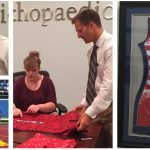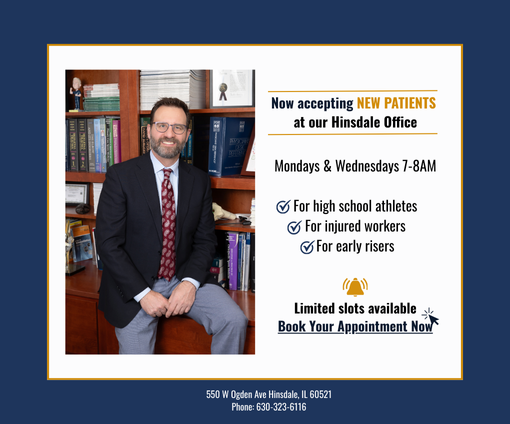Athlete and an ACL Injury: When is it safe to return to your sport?
How do you know when you are ready to play after an ACL injury?
Following anterior cruciate ligament (ACL) surgery, I have my athletes complete a specific return-to-play program consisting of a number of quantitative and qualitative physical challenges. These challenges let me know when the injured knee is ready and that we corrected the neuromuscular control (movement) errors that put the athlete at risk in the first place. Training athletes to move, cut, jump and land properly can help prevent ACL injuries because most ACL injuries occur without any significant contact when an athlete stops quickly on a single planted foot to change directions, or lands after a jump. A few examples of noncontact ACL injuries include Chicago Bears tight end Henry Melton and defensive tackle Nate Collins, and of course, Chicago Bulls point guard, Derrick Rose.
Derrick Rose took more than one year to return to play yet Minnesota Vikings’ running back Adrian Peterson and Denver Broncos’ wide receiver Wes Welker took significantly less time even though they all had torn ACLs. Why is this the case?
No athlete or injury is exactly same. The majority of my ACL patients return confidently and safely to their sports approximately five months after surgery, but some may take longer. The average professional football player takes 54 weeks to return after an ACL injury. Adrian Peterson and Wes Welker are exceptions and their recovery emphasizes that every athlete is different which is why it is important to treat each ACL individually—from surgery and rehabilitation to the decision to return to play. A good doctor will do this to ensure a safe and successful return, and the best results for the athlete. When an ACL patient resumes activity too early, they may be increasing the risk of re-injuring their knee.
Will athletes be back to 100 percent after surgery?
Studies show that most professional football players return with diminished performance and professional basketball players typically maintain their statistical level (points, rebounds, assists, etc.), but many injure their ACL’s at a point in their career when their production is not at its peak. The majority of my patient athletes report their knees feel great and perform well following ACL surgery. However, all ACL injuries come with a cost—a high risk for developing post-traumatic (post-injury) arthritis. Therefore, precautions should be taken to minimize the risk for sustaining an ACL injury by including strength, conditioning and ACL-specific prevention exercises in your workout routines.
What is the most important thing for athletes to do during recovery?
The most important thing for an athlete recovering from ACL surgery is to be patient. Most athletes have the dedication and hard work it takes to do the rehabilitation and achieve a good outcome. However, they often have difficulty giving their knee enough time to recover appropriately. Many push too hard and encounter setbacks and flare-ups that actually delay their return. It is very important patients listen to their doctor’s and therapist’s instructions to achieve the best and most timely results.
Is it always necessary to have surgery/does the type of surgery make a difference?
For athletes of all skill levels, surgery is necessary to restore stability to the knee and allow high-level function. For others who have lower level activity demands, ACL injuries do not always require surgery. After proper rehabilitation, many people can perform daily living tasks, run, bike, lift weights, or even sometimes ski less aggressively without a working ACL. However, even with proper rehabilitation, the knee with the torn ACL is at risk for further meniscal and cartilage injury and can continue to feel unstable. For these reasons, many people who are not competitive athletes decide to have ACL surgery. Surgery also is necessary if the injury involves other knee ligaments, cartilage and/or meniscus (the cushion of cartilage between your femur and tibia), or if a young, active child tears his/her ACL.
Athlete or not, when surgery is indicated, it is imperative that the surgeon anatomically reconstruct the ACL in order to best restore proper function to the knee. As an expert in arthroscopic ACL surgery, I too often see failed ACL surgeries caused by technical errors where the reconstructed ACL graft is placed improperly. Fortunately, I can fix them but at a significant cost to the athlete/patient who must endure another five or more months of recovery and rehabilitation time that can sometimes threaten a scholarship, career, or a job.
What can athletes do to prevent a second tear?
Through my foundation, the Orthopaedic Surgery and Sports Medicine Teaching and Research Foundation (OTRF), I developed an in-season injury prevention program and functional capacity return-to-play challenge. The in-season program trains athletes to run, cut, jump and land in ways that lowers their risk for injury. My return-to-play program helps me determine not only if the athlete’s knee is fully rehabilitated, but also that the athlete is trained to safely run, cut, jump and land in ways that decrease the risk for re-injury and injury to the non-injured contralateral (other) knee. Together these assessment tools help ensure the athlete is ready to return to their sport.
Do some sports take longer to get back to than others?
Yes. Sports that involve more cutting, jumping and landing definitely require more time.
Any other recommendations or comments would be great
Although recently we have heard about many male athletes injuring their ACLs, current research shows female athletes are much more likely to tear their ACLs than their male counterparts. Researchers believe this is because of the differences in how men and women move when making sudden adjustments while performing ACL-risky maneuvers. Women tend to land with less bend in their knees and in a more valgus knee (knock-kneed) position with greater quadriceps (front thigh muscle) force and less hamstring (back thigh muscle) force. The researchers also found women tend to have higher external landing forces than men that result in increased ACL strain and risk for injury. Therefore, it is important for female athletes in sports such as soccer, basketball, volleyball, tennis and gymnastics to incorporate in-season training in their exercise routines to help prevent an ACL injury.
When the ACL tears, you often hear a “popping” sound followed by functional knee instability that typically prevents further participation that day (some do not have much pain). Additionally, you may have delayed swelling in the knee and a feeling your knee could give out when you walk.
An ACL tear diagnosis typically is made using the Lachman Test, a simple physical exam maneuver a doctor can perform on the field or in the office. Even though the diagnosis can often be made with only a physical exam, other tests including X-ray and magnetic resonance image (MRI) are needed to diagnosis other possible associated injuries including fractures, meniscal and cartilage tears and other ligament injuries. Therefore, it is best to see an orthopaedic specialist for a proper diagnosis so the correct treatment and rehabilitation can begin and the patient can return to their sport/job safely and as quickly as possible.
Last, ACL tears can occur at any age—even in children. With an ever-increasing number of year round sports for children and adolescents, I am seeing a growing number of ACL tears in children as young as age eight. Because they are still growing, most orthopaedic surgeons will not operate to repair a torn ACL because current surgery techniques risk damage to the growth plates. This can result in deformity and uneven leg growth. To solve that problem, I developed a special arthroscopic technique that replaces the ligament while completely avoiding the growth plates. My patients who have had this procedure have had excellent outcomes. All are back to their sports, including extreme martial arts.









